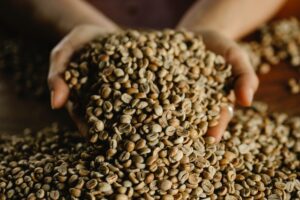Last Updated on 04/06/2023 by Miki
Table of contents
Roasting coffee for espresso is a complex process that must be done with precision and care. The perfect roast can make all the difference in the flavour, aroma, and overall quality of your espresso. In this blog post, we will explore the art and science behind roasting coffee for espresso. We will examine the different stages of the roasting process, the types of beans that are best suited for espresso, and the various roasting techniques that are used by professional roasters. Whether you are a home barista or a coffee enthusiast looking to expand your knowledge, this guide will provide you with everything you need to know about roasting coffee for espresso.

What Roast of Coffee is Best for Espresso?
Several factors can affect the taste and quality of your espresso, and the roast of coffee is one of the most crucial factors that you shouldn’t overlook.
Espresso is a unique brewing method that requires a specific type of coffee roast, which is usually darker than other types of coffee roasts. The best roast for espresso is typically a dark roast, which is roasted for a more extended period than lighter roasts. Dark roasts are known to produce bolder, richer, and more full-bodied flavours that are perfect for espresso.
The dark roast coffee beans go through a more lengthy roasting process, which causes the beans to become darker and oilier than other roasts. This process also causes the beans to lose some of their natural acidity, making them less acidic than lighter roasts. As a result, dark roasts are favoured for espresso because the extraction process of the coffee grounds produces a more concentrated and potent coffee flavour, perfect for this brewing method.
This post may contain affiliate links. If you use these links to purchase something, I may earn a commission without any extra cost to you. I would appreciate it if you do so to keep this blog going!
How to Roast Coffee for Espresso
Roasting coffee for espresso is a delicate process that requires precision and attention to detail. But don’t be intimidated! I’m here to help you achieve your goal 🙂 Here’s a guide on how to roast coffee for espresso.

Step 1: Select Your Coffee Beans
It all starts with high-quality coffee beans. Although single-origin beans have distinct flavours and aromas that some people enjoy, blended beans are recommended for espresso to bring out the best characteristics of each bean.
Step 2: Preheat Your Roaster
Preheat your roaster to the recommended temperature. The ideal temperature for espresso roasting is between 204°C to 232°C (400°C to 450°C). If you are a beginner in roasting coffee, I recommend using a GIVEROO coffee bean roaster.
Step 3: Load Your Coffee Beans
Load the coffee beans into the roaster and ensure that they spread evenly. Use the recommended weight of coffee beans for your roaster to achieve the perfect roast.
Step 4: Monitor the Roasting Process
Watch the beans as they roast, and monitor their colour and aroma. As the name suggests, the light roast has a lighter colour and the dark roast has a darker colour! As the roasting proceeds, the beans should start to turn brown and release a delicious aroma.
Step 5: First Crack
Listen for the first crack, which sounds like popcorn popping. This indicates that the beans have reached the light roast stage. If you prefer a lighter roast for espresso, you can stop the roasting process at this point.
Step 6: Second Crack
Continue roasting until you hear the second crack, which sounds like rice krispies popping. This stage is referred to as the medium roast, which is ideal for espresso. At this point, the beans will start to release oils, and you will notice that the flavours become more complex.
Step 7: Stop the Roasting Process
Once you achieve the desired roast level, remove the coffee beans from the roaster quickly. Transfer the beans to a cooling rack or a colander and let them cool for several minutes. The beans will continue to roast even after you remove them from the heat, so it’s essential to cool them quickly.
Step 8: Store Your Espresso Roast
Store your freshly roasted espresso beans in an airtight container and grind them just before brewing to retain their freshness. Enjoy your rich, flavorful espresso!
Follow these steps to roast coffee beans for espresso, and you’ll be able to enjoy a delicious cup of espresso in no time.
No coffee bean roaster at home? No worries! There are several methods that you can try roasting coffee for espresso without a roaster. Read the article on “How to roast coffee beans at home.”

How Long After Roasting is Coffee Good for Espresso?
Roasting is an essential step in the coffee-making process. It is the process of heating green coffee beans to transform them into brown, aromatic beans that we are all familiar with. After roasting, the coffee beans need to be rested before they can be used to make espresso. The question is, how long after roasting is coffee good for espresso?
The optimal time for resting coffee beans after roasting varies depending on several factors such as the origin of the coffee, the roast profile, and the brewing method. However, the general rule of thumb is that coffee beans should rest for around 24 to 72 hours after roasting before they can be used to make espresso. During the resting period after roasting, coffee beans undergo a process called degassing. Degassing refers to releasing carbon dioxide gas that builds up inside the beans during the roasting process. If coffee beans are not given enough time to degas, the carbon dioxide gas can cause the espresso to taste sour or overly acidic. Therefore, it is crucial to allow coffee beans to rest and degas before using them to make espresso.
Roasting Coffee for Espresso vs Filter
Roasting coffee is an essential step in the coffee-making process, and the roast type can greatly impact the flavour profile of the coffee. When it comes to roasting coffee for espresso vs. filter, there are certain differences in the roasting process that can lead to differences in the final cup.
Espresso Roasting
Espresso roasting is a process that aims to produce coffee beans that are ideal for use in espresso machines. Espresso coffee is characterised by its full body, bold flavour, and creamy crema. To achieve this unique flavour profile, espresso beans are roasted slightly longer than filter coffee beans.
Espresso roasting is typically performed for a longer duration to create a darker roasted bean with a rich, full-bodied flavour. The darker roast allows for more caramelisation to occur within the beans, which imparts a sweeter flavour profile while minimizing any sour or acidic undertones.
Filter Roasting
Filter roasting, on the other hand, is a process that aims to produce coffee beans that are ideal for use in drip coffee makers, pour-over, and other filter brewing methods. Filter coffee is characterised by its lighter body, subtle flavours, and bright acidity.
The roast for filter coffee beans is typically lighter than that of espresso beans, and the roast is finished for a shorter duration. This allows for the beans to develop nuanced and subtle flavour notes, with a greater emphasis on the natural origin flavours of the coffee.
Final Thoughts
In conclusion, roasting coffee for espresso requires a meticulous process that must be followed with precision. The art of crafting the perfect espresso shot is not something to be underestimated, and it all starts with the quality of the beans and the roasting process. Employing the right roast profile is key to unlocking the full potential of your beans, and finding that sweet spot takes time, patience, and practice. Whether you’re an experienced roaster or just starting out, there’s always room to experiment and refine your techniques. So keep exploring, keep learning, and above all, keep enjoying the exquisite flavour of a well-roasted espresso.
